Swami Vivekananda
In 1897 Swami Vivekanand arrived in America as an anonymous and penniless sannyasin (wandering monk). He had travelled to America as a representative of Hindusam and the ancient Indian tradition of Vedanta. Yet Vivekananda was not bound by any formal ties of religion. To the World Parliament of Religions he offered a message of a shared spirituality and the harmony of world religions. This universal message and his dynamic spiritual personality won the hearts and minds of many seekers; and his vision is still treasured today.
“Arise! Awake! And stop not till the goal is reached.”
- Vivekananda
Early Life of Vivekananda
Vivekananda was born to an orthodox Hindu family in Bengal 1863. From an early age he displayed signs of great compassion and also the qualities of a natural leader. Vivekananda had a sharp intellect and devoured literature from both East and West. This included Western philosophy and the great English poets. Vivekananda particularly liked the rational reasoning of the West and was easily dismayed by many of the religious superstitions and the cultural decline that Indian society found itself in. Thus Vivekananda was drawn to join the Brahmo Samaj. The Brahmo Samaj was a modern Hindu movement who sought to revitalise Indian life and spirituality through a rationalistic approach and abandonment of image worship.
However the rationality of the Brahmo Samaj could not satisfy the latent spiritual hunger of Vivekananda. From an early age he began to have spiritual experiences and at the age of 18 felt an overwhelming desire to “See God”. With a directness that was typical of Vivekananda he asked those around whether they had seen God. All affirmed in the negative. This included the great Devendranath Tagore (father of Rabindra Nath Tagore) However Devendranath told Vivekananda that he saw in him the eyes of a Yogi and surely he would Realise God in this lifetime. Although none could satisfy his question, he came to hear of the name Ramkrisna ParamHans who was reputed to be a great Spiritual Personality and had realised God.
Ramakrishna - Vivekananda
In many ways Ramkrishna was different to Vivekananda. Ramakrishna was an illiterate and simple villager who had taken a post at a local Kali temple. However his simple exterior hid a personality of extraordinary spirituality. For many years Ramakrishna had pursued the most intense spiritual practices burning with a longing for realisation of his beloved Mother Kali. But after attaining realisation, Ramakrishna not only practised Hindu rituals, but also pursued the spiritual paths of all the main religions. Sri Ramakrishna came to the conclusion that all religions lead to the same goal of union with the infinite. It was thus fitting that his closest disciple, Vivekananda would later eloquently spread this message, - the harmony of world religions. As Sir Aurbindo would later say:
" the Master (Sri Ramakrishna) marked out Vivekananda as the heroic soul destined to take the world between his two hands and change it."
Ramakrishna instantly recognised the spiritual potential of Vivekananda and lavished attention on Vivekananda, who at first did not always appreciate this. In the beginning the reasoning mind of Vivekananda was sceptical of this God intoxicated Saint and Vivekananda would frequently question and debate his teachings. However, slowly the spiritual magnetism of Sri Ramakrishna melted Vivekananda’s heart and he began to experience the real spirituality that Ramakrishna exuded. Thus Vivekananda mental opposition faded away to be replaced by an intense surrender to the Divine Mother and a burning longing for realisation.
For a short but intense period of about 5 years, Vivekananda learnt directly from his Master Sri Ramakrishna. Sri Ramakrishna was able to awaken the dormant spiritual consciousness in his beloved disciple and Vivekananda soon began to experience profound states of consciousness and samadhi. After the passing of Ramakrishna, the other disciples looked to Vivekananda for leadership and he helped form the first monastic order of Ramakrishna. Under his constant guidance he urged his fellow brother disciples to renounce the world and seek communion with God.
However for Vivekananda, personal liberation was not enough. His heart ached for the downtrodden masses of India who suffered poverty and many hardships. Vivekananda felt that the highest ideal was to serve God through serving humanity. Thus Vivekananda would later add social work as an important element of the Ramakrishna order. Thus after spending a few years in meditation Vivekananda became restless and began travelling throughout India, visiting many of the holy sites. After travelling through India and coming into contact with many influential figures, it was suggested that Vivekananda would make an ideal candidate to represent Hinduism at the World Parliament of Religions which was shortly to be held in Chicago, USA. Before leaving Vivekananda went to receive the blessings of Sarada devi, the wife of Sri Ramakrishna. After receiving her encouragement and blessings he made the momentous journey to America dressed in his ochre robe and maintaining the vows of a Sanyasin
Vivekananda – World Parliament of Religions.
Vivekananda at the Parliament of World Religions
At the opening ceremony Vivekananda was one of the last speakers to speak. The previous speakers had talked about the merits of their own religion but Vivekananda appealed to the whole audience with his vision of oneness and equality before God.
His opening words began with.
“Brother and Sisters of America.” … Spontaneously the audience rose to its feet to applaud, perhaps appreciating the visionary sentiments Vivekananda offered.
Swami Vivekananda was chosen to represent Hinduism. However Swami Vivekananda did not try in any way to prove the superiority of his religion. Instead Vivekananda spoke with great sincerity about the harmony of world religions and the common spirituality of humanity. It was this universal message of oneness which captivated the audience.
“As different streams, having their sources in different places, all mingle their water in the sea, so, O Lord, the different paths which men take through different tendencies, various though they appear, crooked or straight, all lead to Thee.”
Video of Swami Vivekananda's Speech to World Parliament of Religions 1893
Vivekananda proved to be an eloquent exponent of Vedanta and the ideals of all religions. In addition people felt in this handsome and striking Monk a calm detachment, a luminous personality and radiant spirituality. Unexpectedly Vivekananda proved to be the star of the World Parliament of Religions
The New York Herald said of Vivekananda.
“He is undoubtedly the greatest figure in the Parliament of Religions. After hearing him we feel how foolish it is to send missionaries to this learned nation.”
The Boston Evening Post said.
“If he (Vivekananda) merely crosses the platform he is applauded; and this marked approval of thousands he accepts in a childlike spirit of gratification without a trace of conceit…”
Throughout the conference Vivekananda was undoubtedly the star, the organisers would save Vivekananda to the end to make sure the audience would stay to listen.
The conference propelled Vivekananda into the public eye and for many months he travelled across America giving talks on the ancient tradition of Vedanta and his hope of fusing the spirituality of the East with the materialism of the West.
In America Vivekananda also began training some close students so they could propagate the teachings of Vedanta. He was able to start small centres in both the US and Great Britain. Vivekananda admitted he entered Britain with deep misgivings since his heart rebelled at the effects of the British Empire on his beloved motherland. However he was delighted to find some individuals who were sincerely attracted to the teachings of Vedanta. One notable example was Miss Margaret Noble (later named Nivedita), originally from Ireland, Nivedita was to became a devoted disciple who would dedicate her life to the Indian people)
After several years in the West, Vivekananda returned to India where he was met with a rapturous reception. In particular, his brother monks who were full of pride with Vivekananda who had returned with glowing praise. Despite falling health Vivekananda threw himself into a whirlpool of activity reorganising the monasteries and exhorting his fellow Indians to return to the truth of the Vedantic principles. But also Vivekananda sought to imbibe in the Indian consciousness a renewed dynamism to improve their material life. As Vivekananda often said, it was no use teaching religion to those with empty stomachs.
Vivekananda passed away at the young age of 39 but he achieved a remarkable amount in this short time on earth. He combined the ancient spiritual traditions of India with the dynamism of the West. Many Indian politicians would later offer their gratitude to the impact and ideals of Vivekananda. To many Vivekananda is regarded as the patron saint of modern India.
Swami Vivekananda's temple at Belur Math where he was cremated.
 Personal information
Personal information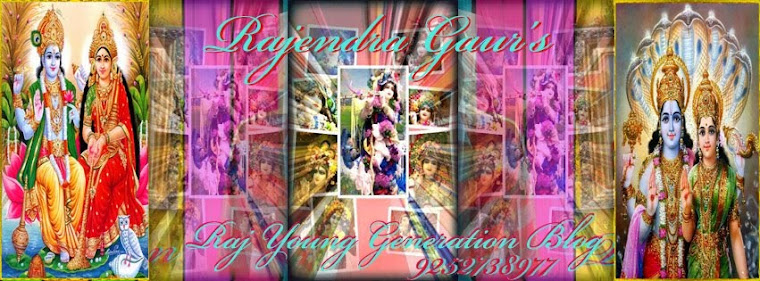










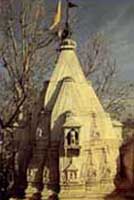
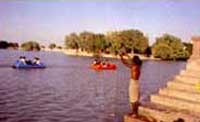
 In Ramdevra the main attraction is the Samadhi-Mandir, the temple of Ramapir, which includes the samadhis of his parents, King Ajmalji and the Queen Mata Meenaldevi. The other samadhis are of his grandfather Raja Ranjitsinhji and the elder brother Viramdevji and the two sons of Ramdevji. There are also some more Samadhis of close family relations of Ramdveji.
In Ramdevra the main attraction is the Samadhi-Mandir, the temple of Ramapir, which includes the samadhis of his parents, King Ajmalji and the Queen Mata Meenaldevi. The other samadhis are of his grandfather Raja Ranjitsinhji and the elder brother Viramdevji and the two sons of Ramdevji. There are also some more Samadhis of close family relations of Ramdveji.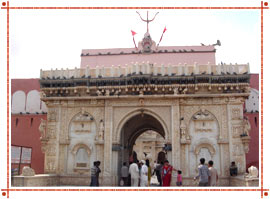 The Karni Mata temple, Deshnok is situated 30 km from Bikaner. The temple is dedicated to an early 15th century mystic, considered to be a reincarnation of Goddess Durga. This temple is quite famous for a large number of brown rats running around the temple complex fearlessly. It is believed that the souls of dead Charans (traditional bards, the devotees of Mata) reside in these rats. It is considered very lucky to spot a rat in the temple. During the time of aarti, these rats are offered sweets, grains, etc by the devotees.
The Karni Mata temple, Deshnok is situated 30 km from Bikaner. The temple is dedicated to an early 15th century mystic, considered to be a reincarnation of Goddess Durga. This temple is quite famous for a large number of brown rats running around the temple complex fearlessly. It is believed that the souls of dead Charans (traditional bards, the devotees of Mata) reside in these rats. It is considered very lucky to spot a rat in the temple. During the time of aarti, these rats are offered sweets, grains, etc by the devotees.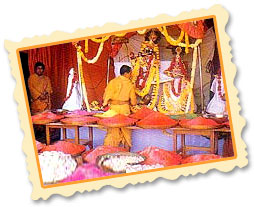 Govind Dev Ji Temple is one amongst the major tourist attractions of Jaipur. The Temple represents the royal past of Jaipur. The Temple is dedicated to Govind Dev Ji (Other name of Lord Krishna). Govind Devji Temple of Jaipur is situated in the City Palace complex, between the Chandra Mahal and Badal Mahal. Govind Dev Ji is the principal deity of Amber's Kachawaha Dynasty. In the earlier times, the idol of the lord used to reside in the temple of Vrindavan in Uttar Pradesh.
Govind Dev Ji Temple is one amongst the major tourist attractions of Jaipur. The Temple represents the royal past of Jaipur. The Temple is dedicated to Govind Dev Ji (Other name of Lord Krishna). Govind Devji Temple of Jaipur is situated in the City Palace complex, between the Chandra Mahal and Badal Mahal. Govind Dev Ji is the principal deity of Amber's Kachawaha Dynasty. In the earlier times, the idol of the lord used to reside in the temple of Vrindavan in Uttar Pradesh.